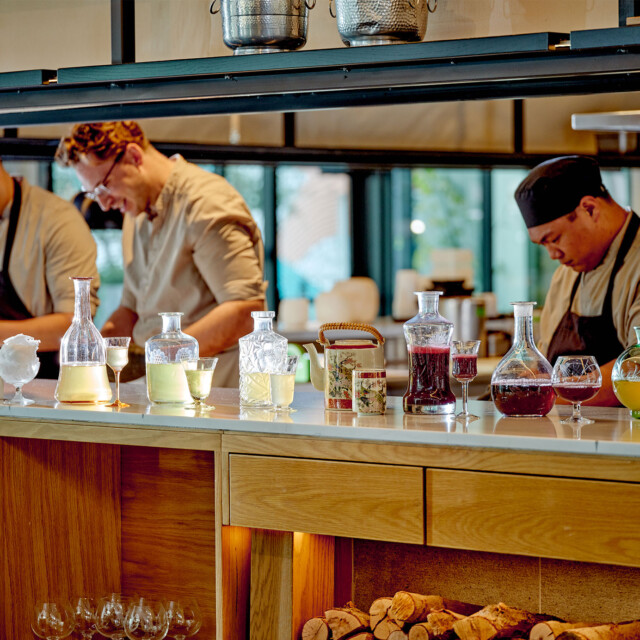It is exceptionally difficult to craft cocktails that are complex, delicious, and memorable without alcohol. Booze provides flavor, body, and the obvious inebriating effect that eases inhibitions and sets the scene for a good night out. The effect of alcohol can even help mask when a cocktail isn’t perfectly balanced.
In a bar setting, price points provide an additional layer of difficulty for non-alcoholic cocktails. Inputs like rent, labor, glassware, ice, and raw ingredients usually mirror their boozy counterparts exactly — spirits aren’t as big a driver of cost as you might think they are — but guests are often disgruntled if not downright offended when asked to pay cocktail prices for drinks they perceive as “just juice.” For bars that are gunning for international acclaim, it’s no longer an option to simply opt out of an N/A program. The cocktail community wants to see those drinks on menus whether or not they’re going to order them. It’s an incredible challenge for bartenders to provide delicious drinks that are economical for the house, push creativity forward for the community, and provide a high value proposition for the average guest.
When opening the current iteration of Kato in Los Angeles, bar director Austin Hennelly decided to meet these challenges head on, and set out to build a world-beating non-alcoholic program. Since its relocation and reopening in 2021, the Taiwanese-American tasting menu has been named L.A.’s No. 1nrestaurant twice by the L.A. Times, and every glowing review highlights the outstanding quality of its N/A program.
On a sunny L.A. morning, I joined Austin and his head bartender and partner in all things creative behind the bar, Han Suk Cho, to learn the ins and outs of their remarkable work, and how they transform a traditional N/A offering with stunning effects.
A New Paradigm for Non-Alc
“The alcohol-free program at Kato was actually one of the first things that I talked about with John (Yao, chef and co-owner) and Ryan (Bailey, wine director and co-owner) when I came aboard,” Austin says.
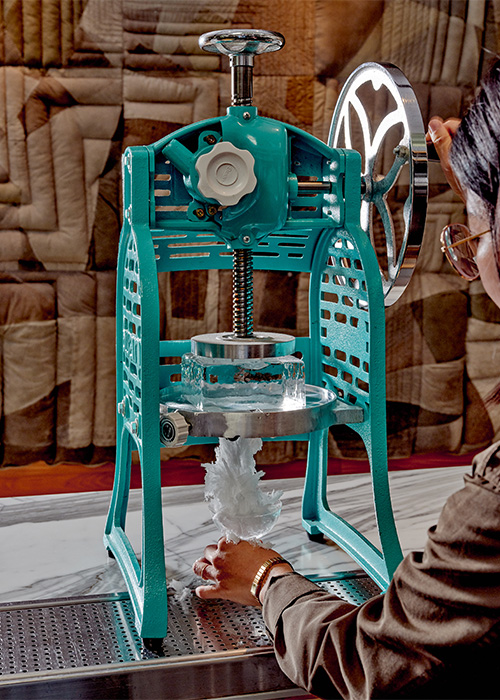
Los Angeles’s long-standing focus on health-conscious dining aligns with a higher percentage of diners who abstain from alcohol for any reason. Austin’s personal choice to stop consuming alcohol coincided with building out this bar program. He took it as an opportunity to discover the most delicious products on the market that he could consume and, in turn, share with his guests. “We want to have so many and such diverse options that there’s really no opportunity for someone to just say water,” he says.
Kato offers a full page of dealcoholized wines by the glass and bottle, N/A beer, verjus (unfermented grape juice that could have become wine), sparkling tea, kombucha, N/A cocktails, and — the crown jewel of the alcohol-free program — the “Alcohol-Free Pairing,” a progression of N/A drinks created by the team to match with every course of the tasting menu.
Since they implemented this expansive offering, the number of guests who consume no alcohol at all has stayed flat at around 15 percent. But the number of guests who engage with both alcohol and the alcohol-free offerings — with cocktails then the N/A pairing, or N/A cocktails and the wine pairing, or alternating between boozy and alcohol-free offerings throughout the meal — has surged to 30 percent of total guests. The primary driver of this sales increase is the pairing. And the key to the success of the pairing is a transformative technique developed by Austin and Han.
Building the Pairing
“Austin calls it ‘Weirdo Sangria,’” Han jokes, referring to a new category of drink that they pioneered. It starts with dealcoholized wine — traditional wines that undergo a low-temperature distillation under vacuum (basically in a giant rotovap) to remove the alcohol while leaving behind the majority of the flavor. It does a good job retaining most of the varietal character of the fruit, but strips the flavor, body, and texture provided by the alcohol. Although they use the highest-quality dealcoholized wines on the market from producers like Weingut Leitz out of Germany, the category “just does not have as much character as high-quality wine,” Han explains. So the duo decided to add that character back.
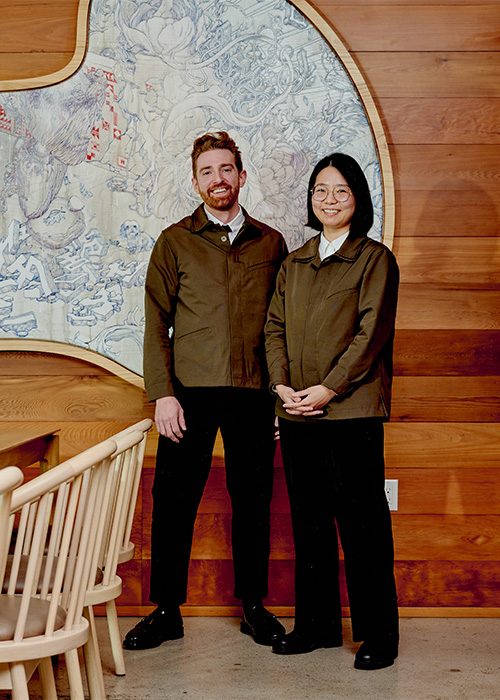
First, they handle texture. The wines are steeped with ingredients that add body and aroma. Kelp, tea, fruit skins, dried herbs, and spices are all candidates. Ingredients that also introduce bitterness, like gentian, are useful in trace amounts. “At a barely perceptible threshold, it makes up for the lack of alcohol heat by giving you a little bit of a bitter bite,” Austin says. Kelp provides salinity and minerality. Cocoa nibs or tea can provide tannins.
This process of adding texture is not the end of the story, as it often leaves the wines out of balance — too punchy, aromatic, or grippy. So they are then tamed with the addition of centrifuge-clarified juices, often more than one. Three boxes that each customized wine needs to check are: earthiness, acidity, and texture.
“Some people have never had classic cocktails, so serving something [and saying] ‘oh, it’s like a Martini or it’s like a Negroni,’ might not resonate with them. Some people don’t want to have something like a cocktail when they’re going through recovery.”
Eager to taste them for myself, Austin and Han poured me a sample of the pairing that accompanies the second course, a savory squash donut. The liquid was a dealcoholized Riesling steeped with mango skins for texture, and married with clarified carrot for earthiness and clarified passion fruit for acidity. It was full-bodied, bold, aromatic, and tart. It had the soul of a well-aged Riesling from the Mosel, that savory richness that’s beloved by white wine connoisseurs. I found myself sneaking sips again and again, unable to put it down.
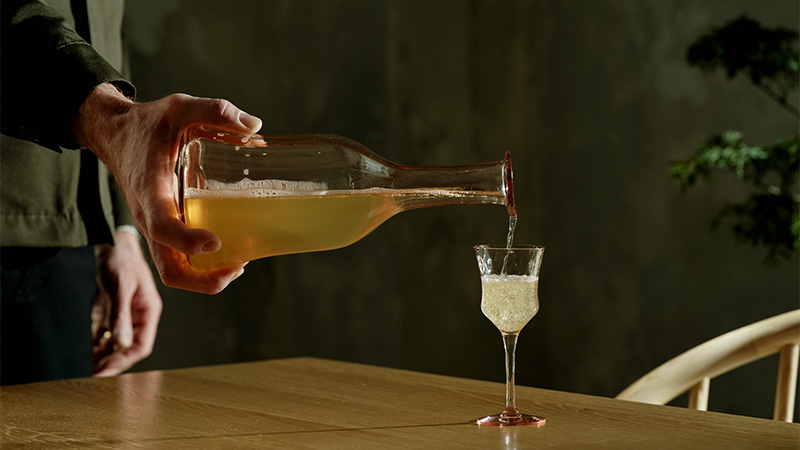
The other advantage of the N/A pairing is Austin and Han’s ability to play with temperature. A three-course chunk of the menu — quail into lamb into beef — would traditionally call for a progression of red wine. The N/A pairing takes that evolution a step further by also fluctuating temperature. The quail is matched with a hot serve of dealcoholized Pinot Noir that’s infused with ginseng, red date, and mandarin. The lamb gets a light, lively, refreshingly cold, gently force-carbonated mint-forward pour, akin to an N/A Lambrusco. The next pairing brings diners back to center with a beef course accompanied by a cellar-temperature, full-bodied red that’s finished with cocoa nib, black tea, and 5-spice. These surprising changes of state provide an experience as dynamic and playful as traditional wine pairings.
The so-called Weirdo Sangrias were featured in six of the restaurant’s eight courses at the time of my visit. The two outliers are the first course and dessert. An N/A cocktail arrives alongside opening snacks to start things whimsically. For dessert, Austin and Han pour a single-variety, old-vine verjus of Riesling that was made specifically for the restaurant by Cole Ranch in Mendocino, Calif.
Developing and executing these creations requires substantially more work than just building cocktails from an existing pool of commercially available ingredients. What’s more, there is no army of bar prep cooks toiling away in a basement kitchen to produce them; if it’s on the menu, either Han or Austin made it.
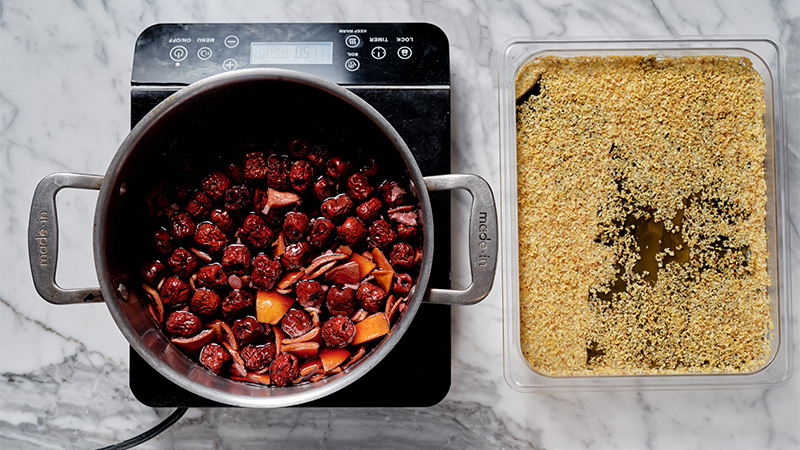
For Han, the additional challenge is worth it to provide a unique and memorable experience for those who abstain or have never tried alcohol. “Some people have never had classic cocktails, so serving something [and saying] ‘oh, it’s like a Martini or it’s like a Negroni,’ might not resonate with them,” she says. “Some people don’t want to have something like a cocktail when they’re going through recovery.”
The other advantage of crafting alcohol-free beverages that are more wine-like is that they won’t overpower or clash with the food. “The important thing to remember is that the pairing is subordinate to the food,” Austin says. Cocktails put bold, brash flavors to the forefront. That intensity would be inappropriate for the subtlety and elegance of each course at Kato. A transformed dealcoholized wine centers the food, adds to the overall experience, and treats the drinker with care and respect.
Weirdo Sangria at Home
After picking up a bottle of dealcoholized Chardonnay at a local shop, I looked at the planned week of cooking I had in store. Monday night featured its own pairing: turkey larb, a spicy and aromatic Thai ground meat salad, and catching up on “The White Lotus” — a perfect opportunity to craft Weirdo Sangria. I cracked the bottle and tasted it. Clearly Chardonnay, and a tasty one at that, it was just a little thin and sad — begging to be transformed.
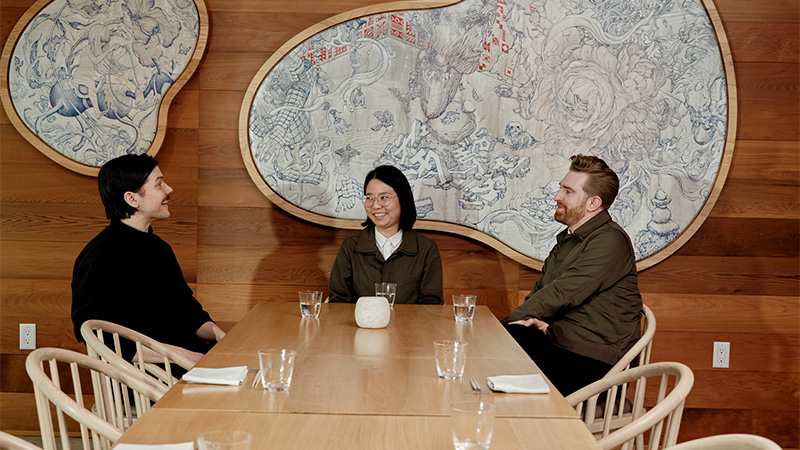
Larb is so herbaceous and spicy it demands something salty and tropical. To add texture, I chose to infuse the Chardonnay with kombu and oyster shells. The shells added minerality while the kombu provided vegetal flavor, salinity, and body. Earthiness and texture covered!
For acidity, I added a combination of clarified pineapple juice and Champagne acid, a 6 percent solution of lactic and tartaric acids dissolved in water. It mimics the flavor of a wine that’s gone through malolactic fermentation, and the process is common in Champagne, so adding these acids calls to mind that flavor profile without adding any actual wine.
Finally, I added a touch of cane syrup from Martinique to round off the sharp edges, add a little additional body, and make everything play nicely together. I chilled the whole mixture as close to freezing as possible and force-carbonated it three times at 45 PSI. This “Ocean Champagne” was a perfect pairing and transformed an otherwise utilitarian weeknight meal into an experience.
Ocean Champagne
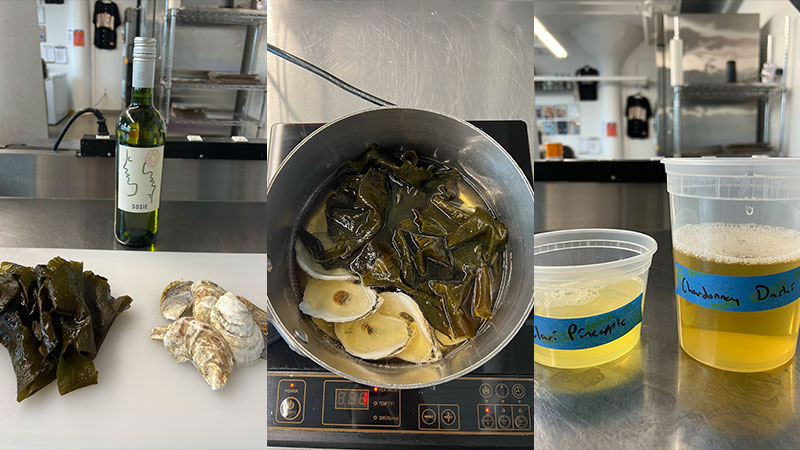
Ingredients
- 500 milliliters Chardonnay Dashi*
- 250 milliliters clarified pineapple juice
- 30 milliliters cane syrup
- 30 milliliters Champagne acid**
Directions
- Add all ingredients to a carbonation bottle.
- Chill in the freezer until nearly frozen.
- Charge three times at 45 PSI, waiting at least a minute and venting between each charge.
- Serve alongside turkey larb in a wine glass.
Chardonnay Dashi*
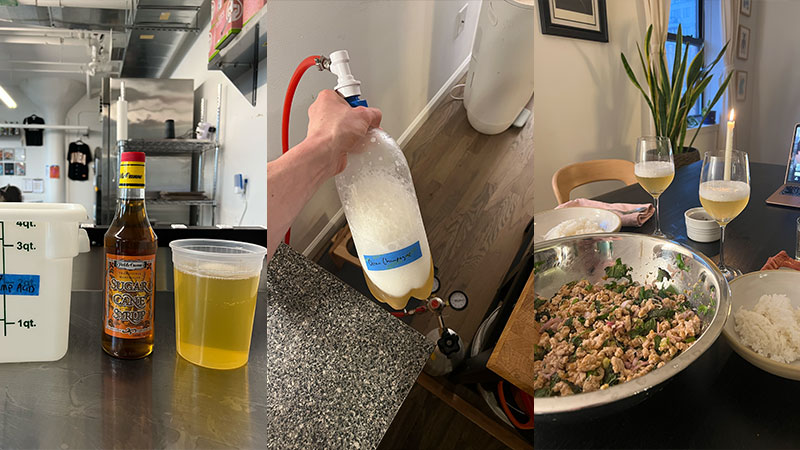
Ingredients
- 750 milliliters dealcoholized Chardonnay
- 75 grams kombu, rinsed to soften and remove all dusty residue
- 8 oyster shells, well scrubbed
Directions
- Add all ingredients to a small saucepan.
- Warm over the lowest heat your stove or induction will allow. The infusion happens quickly, so you should be constantly stirring and tasting. The goal is “sea salt air” not full-on brackish muck.
- Once the Chardonnay is lightly salty, vegetal, and textured, cut the heat and strain immediately. The whole process should take no more than 5 minutes.
- Store in the fridge until you are ready to make Ocean Champagne. Use any excess to deglaze a pan and make sauce after searing fish.
Champagne Acid**
Ingredients
- 3 grams lactic acid powder
- 3 grams tartaric acid powder
- 94 grams water
Method
- Add all ingredients to a container. Stir or shake to combine. Store in the fridge indefinitely.
This story is a part of VP Pro, our free platform and newsletter for drinks industry professionals, covering wine, beer, liquor, and beyond. Sign up for VP Pro now!
